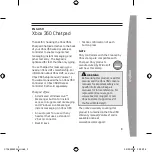
HT# 059296-00A
6
PLL Installation and Operation Manual
PuMP DeLay
3-Call, 3-Flow (3-Pump)
• This configuration is typically used in one, two, or three boiler
pump applications to offer pump delay and alarming. The PLL
control operates a single pump per boiler.
• Each of the pump calls will use a different pump call input (C1,
C2, and C3).
• Also, each of the pump flows will use the respective pump flow
input (F1, F2, and F3).
• No rotation is available in this mode.
• If a pump failed to provide proof-of-flow for over 30 seconds,
the PLL will turn that pump output off and turn on its alarm.
Boiler 1
Boiler 2
Flow
Switch 1
Pump 1
Flow
Switch 3
Flow
Switch 2
Pump 3
Pump 2
Boiler 3
1 2 3 4 5 6 7 8
On
1 2
DO NOT APPLY ANY VOLTAGE
TO INPUT TERMINALS
10 11 12 13 14 15 16 17 18 19
L N
RS-485
VALVES
A1
A2
A3
PWR
24
20
22
21
23
25
29
27
26
28
30
CAUTION:
Risk of Electric Shock. Use Copper Conductors Only.
Wire all circuits as Class I or Electric Ligh and Power Circuits.
2 RESISTIVE, 120VAC
1/4 HP, 120VAC 60Hz, Pilot Duty 80VA, 120VAC
OUTPUT RATINGS:
ALARM 2
ALARM 3
COM
POWER
ALARM 1
PUMP 2
PUMP 3
VALVE 1
VALVE 2
PUMP 1
ALARM
RESET
PLL
PUMP LEAD-LAG
MAXIMUM 6A TOTAL FOR ALL CIRCUITS
INPUT RATINGS: 120VAC 60Hz, 12VA MAX.
DIP SWITCHES
31
C1
C2
C3
F1
F2
F3
PUMP CALL
FLOW INPUTS
ALARMS
V1
V2
L
N
L
N
6 7 8 9
P2
P3
L
N
4 5
P1
L
N
L
N
PUMPS
OUTPUT (SOURCING)
3
G
PuMP exerCIse
• This option is recommended for all pumps as it helps protect the pumps from locking due to sediment deposit and rust in the
system. It proves very beneficial to wet rotor pumps as it helps lubricate their seals.
• When this feature is enabled, The PLL exercises any pump that did not run for a week. The exercise period is 10 seconds.
InsTaLLaTIOn sTePs
Follow these steps to make sure that all aspects of the system installation are done:
1. Mount the PLL control. See "Mounting The Enclosure" on page 7.
2. Wire the PLL control to the power, the pumps, flow inputs, valves, and the alarms. See "Wiring" on page 8.
3. Set the dip switches to match your application. See "Dip Switches" on page 10..
4. Power the control.







































